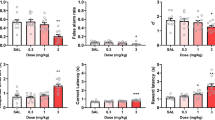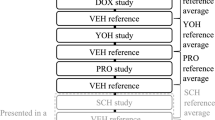Abstract
Rationale
Processes of attention have a heritable component, suggesting that genetic predispositions may predict variability in the response to attention-enhancing drugs. Among lead compounds with attention-enhancing properties are nicotinic acetylcholine receptor (nAChR) agonists.
Objectives
This study aims to test, by comparing three rat strains, whether genotype may influence the sensitivity to nicotine in the 5-choice serial reaction time task (5-CSRTT), a rodent model of attention.
Methods
Strains tested were Long Evans (LE), Sprague Dawley (SD), and Wistar rats. The 5-CSRTT requires responses to light stimuli presented randomly in one of five locations. The effect of interest was an increased percentage of responses in the correct location (accuracy), the strongest indicator of improved attention.
Results
Nicotine (0.05–0.2 mg/kg s.c.) reduced omission errors and response latency and increased anticipatory responding in all strains. In contrast, nicotine dose-dependently increased accuracy in Wistar rats only. The nAChR antagonist mecamylamine (0.75–3 mg/kg s.c.) increased omissions, slowed responses, and reduced anticipatory responding in all strains. There were no effects on accuracy, which was surprising giving the clear improvement with nicotine in the Wistar group.
Conclusions
The findings suggest strain differences in the attention-enhancing effects of nicotine, which would indicate that genetic predispositions predict variability in the efficacy of nAChR compounds for enhancing attention. The absence of effect of mecamylamine on response accuracy may suggest a contribution of nAChR desensitization to the attention-enhancing effects of nicotine.


Similar content being viewed by others
References
Acri JB et al (1995) Strain and age-differences in acoustic startle responses and effects of nicotine in rats. Pharmacology Biochemistry and Behavior 50:191–198
Barnes JJM et al (2011) The molecular genetics of executive function: role of monoamine system genes. Biological Psychiatry 69:E127–E143
Bellgrove MA, Mattingley JB (2008) Molecular genetics of attention. Molecular and Biophysical Mechanisms of Arousal, Alertness, and Attention 1129:200–212
Bushnell PJ et al (1997) Detection of visual signals by rats: effects of chlordiazepoxide and cholinergic and adrenergic drugs on sustained attention. Psychopharmacology 134:230–241
Chen WJ et al (1998) Sustained attention deficit and schizotypal personality features in nonpsychotic relatives of schizophrenic patients. American Journal of Psychiatry 155:1214–1220
Clarke PBS et al (1994) The pharmacology of the nicotinic antagonist, chlorisondamine, investigated in rat-brain and autonomic ganglion. British Journal of Pharmacology 111:397–405
Cousineau D (2007). Confidence intervals in within-subject designs: A simpler solution to Loftus and Masson’s method. Tutorials in Quantitative Methods for Psychology 1:42–45
Decker MW, Majchrzak MJ (1992) Effects of systemic and intracerebroventricular administration of mecamylamine, a nicotinic cholinergic antagonist, on spatial memory in rats. Psychopharmacology 107:530–534
Drisdel RC et al (2008) High affinity binding of epibatidine to serotonin type 3 receptors. Journal of Biological Chemistry 283:9659–9665
Faraday MM et al (2003) Effects of nicotine and stress on locomotion in Sprague-Dawley and Long-Evans male and female rats. Pharmacology Biochemistry and Behavior 74:325–333
Groot AS et al (2004) Familial influences on sustained attention and inhibition in preschoolers. Journal of Child Psychology and Psychiatry 45:306–314
Grottick AJ et al (2003) Reversal of a vigilance decrement in the aged rat by subtype-selective nicotinic ligands. Neuropsychopharmacology 28:880–887
Grottick AJ, Higgins GA (2000) Effect of subtype selective nicotinic compounds on attention as assessed by the five-choice serial reaction time task. Behav Brain Res 117:197–208
Hahn B (2015) Nicotinic receptors and attention. Curr Top Behav Neurosci pp 103–135
Hahn B et al (2003a) Attentional effects of nicotinic agonists in rats. Neuropharmacology 44:1054–1067
Hahn B et al (2002a) Effects of dopamine receptor antagonists on nicotine-induced attentional enhancement. Behav Pharmacol 13:621–632
Hahn B et al (2002b) Nicotine-induced enhancement of attention in the five-choice serial reaction time task: the influence of task-demands. Psychopharmacology 162:129–137
Hahn B et al (2003b) Involvement of the prefrontal cortex but not the dorsal hippocampus in the attention-enhancing effects of nicotine in rats. Psychopharmacology (Berl) 168:271–279
Hahn B et al (2011) Selective nicotinic receptor antagonists: effects on attention and nicotine-induced attentional enhancement. Psychopharmacology 217:75–82
Hahn B, Stolerman IP (2002) Nicotine-induced attentional enhancement in rats: effects of chronic exposure to nicotine. Neuropsychopharmacology 27:712–722
Hahn B, Stolerman IP (2005) Modulation of nicotine-induced attentional enhancement in rats by adrenoceptor antagonists. Psychopharmacology (Berl) 177:438–447
Hamilton KR et al (2010) Behavioral effects of nicotine withdrawal differ by genetic strain in male and female adolescent rats. Nicotine & Tobacco Research 12:1236–1245
Hatzimanolis A et al (2015) Common genetic variation and schizophrenia polygenic risk influence neurocognitive performance in young adulthood. American Journal of Medical Genetics Part B-Neuropsychiatric Genetics 168:392–401
Heishman SJ et al (2010) Meta-analysis of the acute effects of nicotine and smoking on human performance. Psychopharmacology (Berl) 210:453–469
Howe WM et al (2010) Enhancement of attentional performance by selective stimulation of alpha4beta2(*) nAChRs: underlying cholinergic mechanisms. Neuropsychopharmacology 35:1391–1401
Iyaniwura TT et al (2001) Evidence that mesoaccumbens dopamine and locomotor responses to nicotine in the rat are influenced by pretreatment dose and strain. Psychopharmacology 158:73–79
Levin ED, Caldwell DP (2006) Low-dose mecamylamine improves learning of rats in the radial-arm maze repeated acquisition procedure. Neurobiol Learn Mem 86:117–122
Levin ED et al (2013) Improvement of attentional function with antagonism of nicotinic receptors in female rats. European Journal of Pharmacology 702:269–274
Levin ED, Rezvani AH (2002) Nicotinic treatment for cognitive dysfunction. CurrDrug TargetsCNSNeurolDisord 1:423–431
Marks MJ et al (1989) Genetic influences on nicotine responses. Pharmacology Biochemistry and Behavior 33:667–678
McGaughy J et al (1999) Enhancement of sustained attention performance by the nicotinic acetylcholine receptor agonist ABT-418 in intact but not basal forebrain-lesioned rats. Psychopharmacology 144:175–182
Mirza NR, Bright JL (2001) Nicotine-induced enhancements in the five-choice serial reaction time task in rats are strain-dependent. Psychopharmacology 154:8–12
Mirza NR, Stolerman IP (1998) Nicotine enhances sustained attention in the rat under specific task conditions. Psychopharmacology 138:266–274
Morey RD (2008) Confidence intervals from normalized data: a correction of Cousineau (2005). Tutorial in Quantitative Methods for Psychology 4:61–64
Morris SE, Cuthbert BN (2012) Research domain criteria: cognitive systems, neural circuits, and dimensions of behavior. Dialogues Clin Neurosci 14:29–37
Muir JL et al (1995) Reversal of visual attentional dysfunction following lesions of the cholinergic basal forebrain by physostigmine and nicotine but not by the 5-HT3 receptor antagonist, ondansetron. Psychopharmacology (Berl) 118:82–92
Papke RL et al (2001) Analysis of mecamylamine stereoisomers on human nicotinic receptor subtypes. Journal of pharmacology and experimental therapeutics 297:646–656
Pattij T et al (2007) Strain specificity and cholinergic modulation of visuospatial attention in three inbred mouse strains. Genes Brain and Behavior 6:579–587
Picciotto MR et al (2008) It is not “either/or”: activation and desensitization of nicotinic acetylcholine receptors both contribute to behaviors related to nicotine addiction and mood. Prog Neurobiol 84:329–342
Plomin R, Deary IJ (2015) Genetics and intelligence differences: five special findings. Molecular Psychiatry 20:98–108
Polderman TJC et al (2006) A longitudinal twin study on IQ, executive functioning, and attention problems during childhood and early adolescence. Acta Neurologica Belgica 106:191–207
Quarta D et al (2012) Serotonin antagonists in the five-choice serial reaction time task and their interactions with nicotine. Behavioural Pharmacology 23:143–152
Quarta D et al (2007) Different effects of ionotropic and metabotropic glutamate receptor antagonists on attention and the attentional properties of nicotine. Neuropharmacology 53:421–430
Rezvani AH et al (2002) Effects of nicotine and mecamylamine on choice accuracy in an operant visual signal detection task in female rats. Psychopharmacology (Berl) 164:369–375
Rezvani AH et al (2005) Nicotinic-serotonergic drug interactions and attentional performance in rats. Psychopharmacology (Berl) 179:521–528
Semenova S et al (2007) Chronic nicotine administration improves attention while nicotine withdrawal induces performance deficits in the 5-choice serial reaction time task in rats. Pharmacology Biochemistry and Behavior 87:360–368
Singh A et al (2004) Nicotinic acetylcholine receptor system and neuropsychiatric disorders. IDrugs 7:1096–1103
Stolerman IP et al (1995) Nicotine psychopharmacology: addiction, cognition and neuroadaptation. Med Res Rev 15:47–72
Terry AV et al (1999) Dose-specific improvements in memory-related task performance by rats and aged monkeys administered the nicotinic-cholinergic antagonist mecamylamine. Drug Development Research 47:127–136
Turchi J et al (1995) Effects of nicotinic acetylcholine receptor ligands on behavioral vigilance in rats. Psychopharmacology (Berl) 118:195–205
Acknowledgments
We thank Dr. Ian Stolerman for insightful comments on this manuscript.
Funding and disclosure
This work was supported by a grant from the National Institute on Drug Abuse (grant number R01 DA035813 to B.H.). The authors have no competing financial interests in relation to the work described and no financial relationship with the organization that sponsored the research. The authors have full control of all primary data and agree to allow the journal to review the data if requested.
Author information
Authors and Affiliations
Corresponding author
Ethics declarations
The treatment of animals followed the “Principles of Laboratory Animal Care” (NIH publication no. 86-23, 1996) and was approved by the Institutional Animal Care and Use Committee of the University of Maryland School of Medicine.
Rights and permissions
About this article
Cite this article
Hahn, B., Riegger, K.E. & Elmer, G.I. Strain dependency of the effects of nicotine and mecamylamine in a rat model of attention. Psychopharmacology 233, 1427–1434 (2016). https://doi.org/10.1007/s00213-016-4236-7
Received:
Accepted:
Published:
Issue Date:
DOI: https://doi.org/10.1007/s00213-016-4236-7




